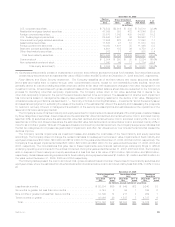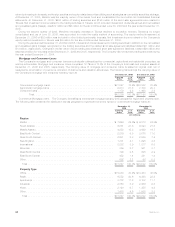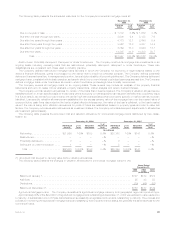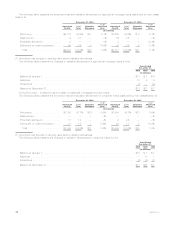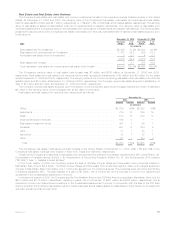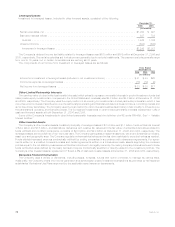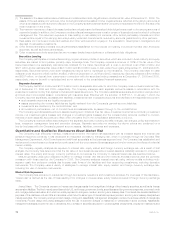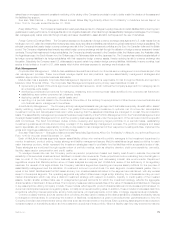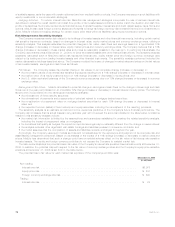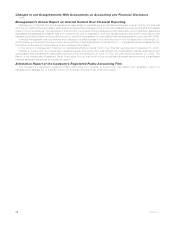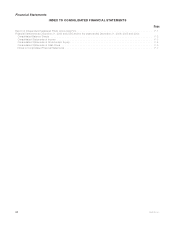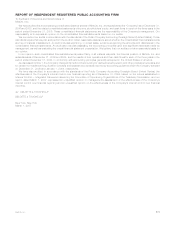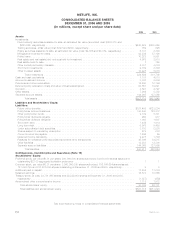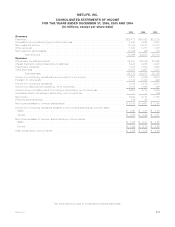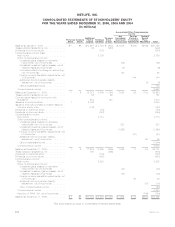MetLife 2006 Annual Report Download - page 78
Download and view the complete annual report
Please find page 78 of the 2006 MetLife annual report below. You can navigate through the pages in the report by either clicking on the pages listed below, or by using the keyword search tool below to find specific information within the annual report.related fees on mortgage loans and consistent monitoring of the pricing of the Company’s products in order to better match the duration of the assets and
the liabilities they support.
See also “Risk Factors — Changes in Market Interest Rates May Significantly Affect Our Profitability” in MetLife’s Annual Report on
Form 10-K for the year ended December 31, 2006.
Equity Market Prices. The Company’s investments in equity securities expose it to changes in equity prices, as do certain liabilities that involve long-term
guarantees on equity performance. It manages this risk on an integrated basis with other risks through its asset/liability management strategies. The Company
also manages equity market price risk through industry and issuer diversification, asset allocation techniques and the use of derivatives.
Foreign Currency Exchange Rates. The Company’s exposure to fluctuations in foreign currency exchange rates against the U.S. dollar results from its
holdings in non-U.S. dollar denominated fixed maturity securities, equity securities and liabilities, as well as through its investments in foreign subsidiaries. The
principal currencies that create foreign currency exchange rate risk in the Company’s investment portfolios are the Euro, the Canadian dollar and the British
pound. The Company mitigates its fixed maturity securities’ foreign currency exchange rate risk through the utilization of foreign currency swaps and forward
contracts. Through its investments in foreign subsidiaries, the Company is primarily exposed to the Canadian dollar, the Mexican peso, the Australian dollar,
the Argentinean peso, the South Korean won, the Chilean peso, the Taiwanese dollar and the Japanese Yen. The Company has matched substantially all of
its foreign currency liabilities in its foreign subsidiaries with their respective foreign currency assets, thereby reducing its risk to currency exchange rate
fluctuation. Selectively, the Company uses U.S. dollar assets to support certain long duration foreign currency liabilities. Additionally, in some countries, local
surplus is held entirely or in part in U.S. dollar assets which further minimizes exposure to exchange rate fluctuation risk.
Risk Management
Corporate Risk Management. MetLife has established several financial and non-financial senior management committees as part of its
risk management process. These committees manage capital and risk positions, approve asset/liability management strategies and
establish appropriate corporate business standards.
MetLife also has a separate Corporate Risk Management Department, which is responsible for risk throughout MetLife and reports to
MetLife’s Chief Financial Officer. The Corporate Risk Management Department’s primary responsibilities consist of:
• implementing a Board of Directors-approved corporate risk framework, which outlines the Company’s approach for managing risk on
an enterprise-wide basis;
• developing policies and procedures for managing, measuring and monitoring those risks identified in the corporate risk framework;
• establishing appropriate corporate risk tolerance levels;
• deploying capital on an economic capital basis; and
• reporting on a periodic basis to the Governance Committee of the Holding Company’s Board of Directors and various financial and
non-financial senior management committees.
Asset/Liability Management. The Company actively manages its assets using an approach that balances quality, diversification, asset/
liability matching, liquidity and investment return. The goals of the investment process are to optimize, net of income tax, risk-adjusted
investment income and risk-adjusted total return while ensuring that the assets and liabilities are managed on a cash flow and duration
basis. The asset/liability management process is the shared responsibility of the Portfolio Management Unit, the Financial Management and
Oversight Asset/Liability Management Unit, and the operating business segments under the supervision of the various product line specific
ALM Committees. The ALM Committees’ duties include reviewing and approving target portfolios on a periodic basis, establishing
investment guidelines and limits and providing oversight of the asset/liability management process. The portfolio managers and asset
sector specialists, who have responsibility on a day-to-day basis for risk management of their respective investing activities, implement the
goals and objectives established by the ALM Committees.
See also “Risk Factors — Changes in Market Interest Rates May Significantly Affect Our Profitability” in MetLife, Inc.’s Annual Report on
Form 10-K for the year ended December 31, 2006.
Each of MetLife’s business segments has an asset/liability officer who works with portfolio managers in the investment department to
monitor investment, product pricing, hedge strategy and liability management issues. MetLife establishes target asset portfolios for each
major insurance product, which represent the investment strategies used to profitably fund its liabilities within acceptable levels of risk.
These strategies are monitored through regular review of portfolio metrics, such as effective duration, yield curve sensitivity, convexity,
liquidity, asset sector concentration and credit quality.
To manage interest rate risk, the Company performs periodic projections of asset and liability cash flows to evaluate the potential
sensitivity of its securities investments and liabilities to interest rate movements. These projections involve evaluating the potential gain or
loss on most of the Company’s in-force business under various increasing and decreasing interest rate environments. Department
regulations require that MetLife perform some of these analyses annually as part of MetLife’s review of the sufficiency of its regulatory
reserves. For several of its legal entities, the Company maintains segmented operating and surplus asset portfolios for the purpose of
asset/liability management and the allocation of investment income to product lines. For each segment, invested assets greater than or
equal to the GAAP liabilities less the DAC asset and any non-invested assets allocated to the segment are maintained, with any excess
swept to the surplus segment. The operating segments may reflect differences in legal entity, statutory line of business and any product
market characteristic which may drive a distinct investment strategy with respect to duration, liquidity or credit quality of the invested
assets. Certain smaller entities make use of unsegmented general accounts for which the investment strategy reflects the aggregate
characteristics of liabilities in those entities. The Company measures relative sensitivities of the value of its assets and liabilities to changes
in key assumptions utilizing Company models. These models reflect specific product characteristics and include assumptions based on
current and anticipated experience regarding lapse, mortality and interest crediting rates. In addition, these models include asset cash flow
projections reflecting interest payments, sinking fund payments, principal payments, bond calls, mortgage prepayments and defaults.
Common industry metrics, such as duration and convexity, are also used to measure the relative sensitivity of assets and liability values
to changes in interest rates. In computing the duration of liabilities, consideration is given to all policyholder guarantees and to how the
Company intends to set indeterminate policy elements such as interest credits or dividends. Each operating asset segment has a duration
constraint based on the liability duration and the investment objectives of that portfolio. Where a liability cash flow may exceed the maturity
75MetLife, Inc.


